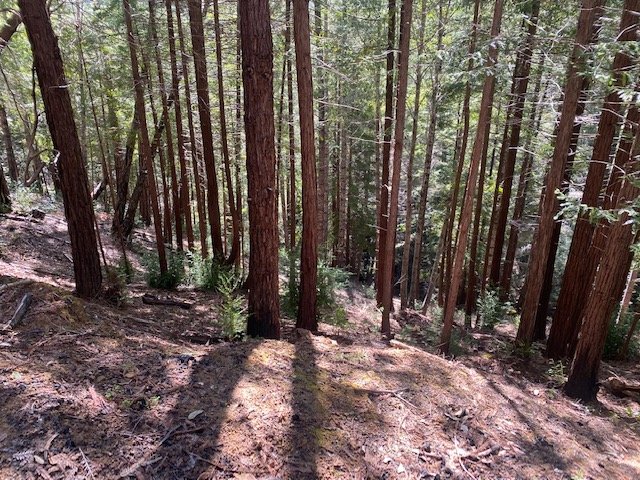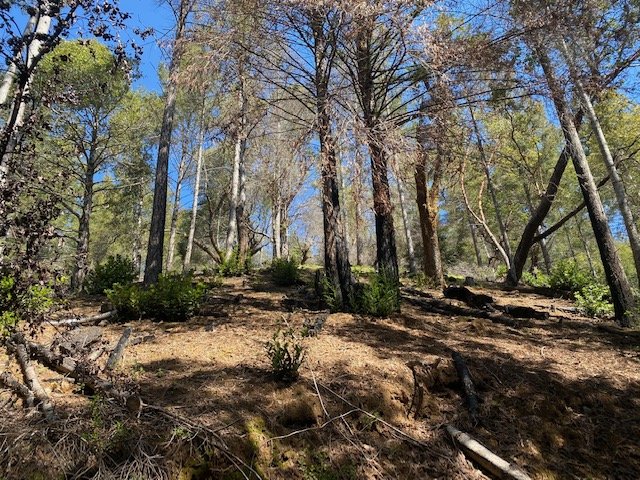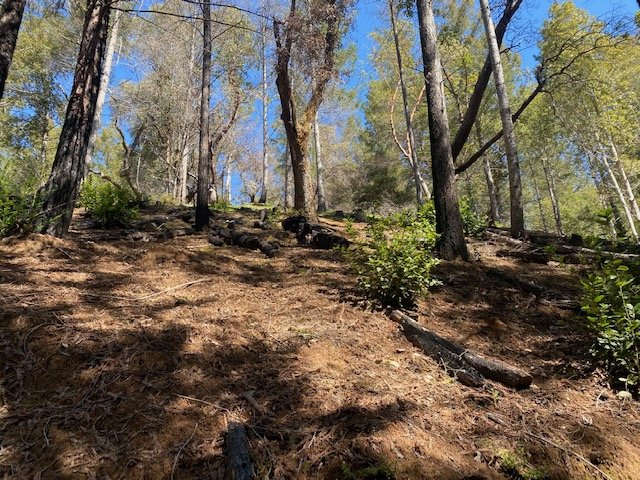Fire Resiliency Field Trip
This past Saturday I joined a group of local folks to tour a property on the Nash Ranch to learn about the work that had been done for fire resiliency. The property has been under the same ownership for the past 30 years and over that time the land owner had become more and more interested in protecting and promoting his forest, while limiting the damage a potential wild fire could cause. This field trip was organized by the Anderson Valley Land Trust (AVLT) and the Anderson Valley Volunteer Fire Department (AVVFD).
The event was limited to 20 attendees but only 18 of us were able to attend; also in attendance were Barbara Goodell and Nancy Horner as well as other members of the AVLT, Mike Jones from the UC Extension and the Mendocino Prescribed Burn Association (PBA), Adam Coleman of the Mendocino Resource Conservation District and Andres Avila, Fire Chief for AVVFD. The rest of the attendees were folks like myself with 20 or more acres of land that they are interested in protecting from wild fire; many of these had attended earlier workshops put on by the AVLT.
The landowner, Dan Sicular, who graciously hosted this group, started things off with a history of the Nash Ranch and his history as the land owner of this particular parcel. In short, the land had been logged at the beginning of the 20th Century, then again by Wilbur Nash. Mr. Sicular was interested in both protecting and cultivating the remaining Redwoods as well as promoting the overall health of his forest. He started this process in 2019 by having the forest manually thinned; the debris from this was left in piles on the forest floor to decompose. The problem with this over the past few years was the lack of rainfall; instead of the moisture encouraging the decomposition of these piles, they simply sat, dry and ready to burn should a fire come through. At this time, Mr. Sicular learned about the Prescribed Burn Association and he became interested in safe burning methods. The first prescribed burn on his property took place in March, 2022; approximately five of his 15 forested were burned.
Chief Avila took over the presentation at this point. He walked us through how a burn is “rolled out.” We were provided with copies of fire plan and the management action points for this particular prescribed burn. Briefly, the fire plan is a document describing how the burn is planned to take place. He did note that not every burn is going to require a plan, but that the size and complexity of the burn will dictate both if and how detailed a plan will need to be. If you’re burning a pile in your front yard your “plan” likely is to have a rake, shovel and hose nearby, to call to confirm it’s a burn day and then to tend the pile. A five acre burn on steep terrain is another matter altogether. The document we were provided included a description of the project area, pre-burn considerations (setting up for the burn), the prescription for the burn, how smoke was to be managed, the ignition plan and post burn activities. The prescription for the burn is key to the burns success; this part included what temperature ranges were acceptable (neither too hot nor too cold), what humidity was acceptable, what direction the wind was blowing and what season the burn was to take place. The smoke management plan was another key consideration. What is going to be in the smoke, for instance? Poison Oak smoke is very different than Redwood duff smoke. Chief Avila also noted that in some cases the Air Quality district will allow a prescribed burn on a non-burn day. The last key piece of this document was the ignition plan. This parts takes in to account the season, the plant and tree growth, the speed and heat of the fire and also the terrain being burned. Finally, a weather forecast is important to have ahead of the planned burn day - however, this will just help with the planning; the more important assessment is the actual weather on the ground the day of the burn.
While all of this planning seems like a lot (this five acre burn produced a 14 page document), the end result is both a higher chance of success and the reduction and/or elimination of the responsibility for paying for fire suppression should the burn escape despite all of these plans. This can be a big incentive to do all of this work ahead of time. (It should be noted that while it eliminates paying for CalFire to help put out an escaped fire, it doesn’t eliminate the chance a neighbor could sue you if the fire were to get out of control and damage that person’s property.)
Mike Jones from the Prescribed Burn Associaton was our last speaker before we toured the burn area. He explained how they can help. They provide a blank burn plan you can use to get started and once you reach a certain point they can help you find a “burn boss” who can help you finalize the plan. He noted that the PBA won’t take part in all burns - they have safety parameters for one thing. Additionally, they expect the landowner to have neighbor buy-in: remember the potential for lawsuits? Getting your neighbors on-board can go a long way to prevent this. Mr. Jones also stressed the weather window’s importance. He noted that beyond the day of the burn, what is the weather for the next week or two going to be? High winds could potentially scatter embers a long way.
What does all of this cost? Like most things, it depends. The day of the actual burn, the gathering of the volunteers and the actual burn, that part is no cost to the landowner if that person utilizes the PBA. The PBA has funding to cover a lot of the costs of the actual prescribed burn; they do ask that the landowner provide food for the volunteers the day of the burn and consider it “nice” if a BBQ is held afterwards for them as well. If the Federal government gets involved they can also provide funds. There are fees for some of the permits, such as the Air Quality permit, which, at least right now, is fairly nominal. The most expensive part of a prescribed burn is the preparation for the burn - bringing in people or equipment to manually thin a forest, or to chop brush away from key trees, to move other burnables away from the same trees, plus any other pre-burn work that is required. There are grants that can help offset this and the PBA can help point you in the right direction.
After all the information about the burn that we had learned we then headed out to walk to where the burn had taken place. Along the way we saw parts of the 15 forested acres that had not been prepared, some that is ready for the next burn and then the parts that had been burned. The parts that had no prep look like most anywhere in this County that hasn’t been maintained - lots of underbrush, lots of downed limbs and some trees, lots of leaves and duff. The parts that had been prepped were clear of all of that and everything was neatly piled up ready to burn. Most impressive was the part that had been burned - there was visibility underneath the trees and the only things on the ground were the remains of logs from the thinning that will decompose over time but don’t leave enough fuel for a wild fire. Additionally, there was green growth of grasses and wild flowers. The end of the walk was highlighted with a small burn. We had seen at the beginning of the walk a “fairy ring” of Redwoods that had been severely burned; one of the lessons learned was that the old stumps can put out a lot of heat when burning and severely damage the new trees growing from it. One way to help prevent that was to burn the duff and limbs near the stumps ahead of time so that the prescribed burn doesn’t reach the stump and burn it and damage the remaining trees. The impromptu burn was the end of our field trip.
I found this a most informative and fun field trip. I am keenly interested in fire as a method of preventing wild fires and wild fire damage. When I was a child my father and his brothers often burned to keep the brush down and only stopped when the State wouldn’t let them continue. It’s good to see this turning around.
I have included links to the Land Trust, the Fire Department and the Prescribed Burn Association in the on-line version of this article. I am also happy to share that information if you reach out to me directly.
An unprepared portion of the property.
Another unprepared portion of the property.
A prepared portion of the property.
A portion of the neighbor’s property being prepared as a line
Images of the post-burn.
Members of the field trip traversing the land that had been burned
The demonstration fire









